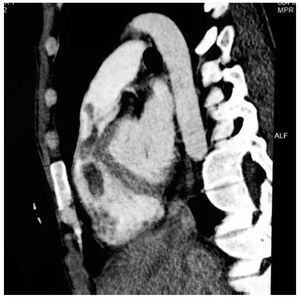To the Editor,
We present the case of a 24-year-old male with history of recurrent painful oral ulcers, which was spontaneously resolved 2 years earlier. He sought medical attention for chest pain, hemoptysis, and fever, and was diagnosed with a respiratory tract infection. The same symptoms appeared 3 weeks later, and a chest radiograph showed a right basal condensation and another small left basal condensation. The patient received wide-spectrum antibiotics and we performed a venous Doppler ultrasound of the legs and a computed tomography angiography (angio-CT) of the pulmonary arteries, with no evidence of thrombophlebitis or pulmonary thromboembolism (PTE). Three weeks later, the patient was readmitted with chest pain and fever. The physical examination revealed only various acneiform lesions on the torso and scar lesions of a few millimeters on the scrotum. There were no signs of pathergy phenomena or ophthalmological abnormalities. The laboratory tests indicated neutrophil leukocytosis (15 000/mL), haemoglobin at 10.6 g/dL, and C-reactive protein at 10.5 mg/dL. Hemocultures and serology tests for Q fever, Legionella, Bartonella, Tropheryma whipplei, Chlamydia, Mycoplasma, and Brucella were negative, as was the bronchial aspirate culture for mycobacteria. The transoesophageal echocardiogram (TOE) shows a mobile, nodular mass in the right ventricle (RV) and another polypoid mass in the RV outflow tract. Magnetic resonance imaging (MRI) of the heart (Figure) detected a 6 to 7 cm filling defect of the RV with polypoid morphology that extended from the RV outflow tract to the pulmonary artery. Suspecting a heart tumor as opposed to an intracardiac thrombosis, we started anticoagulation treatment and resected the mass through cardiac surgery. Pathological anatomy indicated a mural thrombus. The thrombophilia study did not show any abnormalities, and anti-nuclear, anti-DNA, anti-ENA, and anti-neutrophil cytoplasm antibody tests were all negative. Given these findings, the patient was diagnosed with Behçet's disease (BD). Prednisone at 1 mg/kg/day was added to the treatment, yielding immediate improvement in clinical and laboratory parameters, and the acneiform lesions cleared up. Six months later, the patient was asymptomatic, and was being treated with anticoagulants, azathioprine, colchicine, and prednisone (5 mg/day). The anticoagulation treatment was suspended after 7 months, and 4 months later the patient was readmitted with fever. The angio-CT showed a thrombus in the RV with diameter of 2 cm.
Figure 1. Magnetic resonance imaging (MRI) of the heart: 6 to 7 cm filling defect of the RV with polypoid morphology that extended from the RV outflow tract to the pulmonary artery.
Behçet's Disease is considered a multisystemic vasculitis of an unknown aetiology. Diagnosis of BD is exclusively clinical (criteria from the International Study Group for Behçet's Disease),1 and intracardiac thrombosis is a rarely associated condition. A review performed in 2000 compiled 25 cases ocurring between 1966 and 1999.2 By 2008, 22 additional cases were added, with only 2 published in Spain.3,4 Behçet's Disease has a characteristic geographical distribution, with the most incidences along the old Silk Road (80-370 cases per 100 000 inhabitants in Turkey),5 indicating an environmental factor that triggers an auto-immune response in patients with a genetic predisposition. The estimated prevalence of BD in Spain is 5 cases per 100 000 inhabitants.6
Intracardiac thrombosis is a severe condition in BD, with almost 30% mortality and a tendency to recurrence.2 It occurs in males (81.25%) with an average age of 28 years, predominantly in the right chambers (RV, 78%). The clinical manifestations of the disease start with fever (50.9%), haemoptysis (55.4%), and dyspnoea (36.2%).2 It can be associated with a venous thrombosis of the superior and/or inferior vena cava (45.3%),2,4 PTE (41.5%), and aneurysms of the pulmonary arteries (38.3%).2,4,7 Diagnostic and/or therapeutic cardiac surgery is common (49%).2-4,7 The main differential diagnoses are primary heart tumour and infectious endocarditis, using imaging tests (CT, MRI, echocardiogram, and TOE). Treatment consists of glucocorticoids, immunosuppressants,8 and anticoagulation (not used for patients with arterial aneurysm due to the high risk of bleeding).7 In spite of the low prevalence of BD and the rare additional condition of intracardiac thrombosis, it should be taken into account when a young Mediterranean male patient has an intracardiac mass, due to the severity of the condition and need for early treatment.


